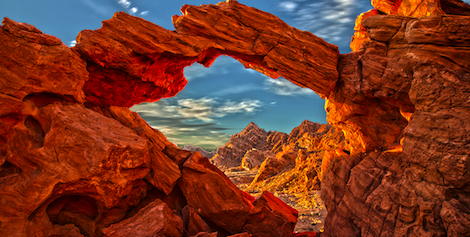Skip to main content
Valley of Fire
Valley of Fire
Valley of Fire State Park is a public recreation and nature preservation area covering nearly 46,000 acres located 16 miles south of Overton, Nevada.
Address: 29450 Valley of Fire Hwy, Overton, NV 89040, United States
Area: 185.9 km²
Elevation: 2,464 ft (751 m)
Valley of Fire State Park is a public recreation and nature preservation area covering nearly 46,000 acres (19,000 ha) located 16 miles (26 km) south of Overton, Nevada.[ The state park derives its name from red sandstone formations, the Aztec Sandstone, which formed from shifting sand dunes 150 million years ago. These features, which are the centerpiece of the park's attractions, often appear to be on fire when reflecting the sun's rays. It is Nevada's oldest state park, as commemorated with Nevada Historical Marker 150. It was designated as a National Natural Landmark in 1968.
Valley of Fire is located 50 miles (80 km) northeast of Las Vegas, at an elevation between 1,320–3,009 feet (402–917 m).It abuts the Lake Mead National Recreation Area on the east at the Virgin River confluence. It lies in a 4 by 6 mi (6.4 by 9.7 km)
History
Prehistoric users of the Valley of Fire included the Ancient Pueblo Peoples, also known as the Anasazi, who were farmers from the nearby fertile Moapa Valley. Their approximate span of occupation has been dated from 300 BC to 1150 AD. Their visits probably involved hunting, food gathering, and religious ceremonies, although scarcity of water would have limited their stay. Fine examples of rock art (petroglyphs) left by these ancient peoples can be found at several sites within the park.
The creation of Valley of Fire State Park began with transfer of 8,760 acres (3,550 ha) of federal land to the state at Nevada in 1931. Work on the park was initiated by the Civilian Conservation Corps in 1933. During the years of their employment, which continued into the early 1940s, the CCC workers built campgrounds, trails, stone visitor cabins, ramadas, and roads.The park opened in 1934; it achieved official designation by the state legislature in 1935.
Climate
The Valley of Fire State Park has a dry and warm climate typical of the Mojave Desert in which it lies. Winters are mild with daytime temperatures ranging from 54 °F (12 °C) to 75 °F (24 °C). and over night lows in the mid 30°F's to mid 40°F's (3-8°C). Storms moving east from the Pacific Ocean occasionally bring rain during winter months. Daily summer highs usually range from 100 °F (38 °C) to 115 °F (46 °C) and on occasion may reach near 120 °F (49 °C). Thunderstorms from the Southwestern Monsoon can produce heavy showers during summer. The average annual precipitation is 6.50" (165.1mm).
Geology
Complex uplifting and faulting of the region, followed by extensive erosion, have created the present landscape. The rough floor and jagged walls of the park contain brilliant formations of eroded sandstone and sand dunes more than 150 million years old. Other important rock formations include limestones, shales, and conglomerates.






Comments